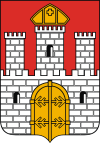 Alternate names: Włocławek [Pol], Vlatzlavek, וולאָצלאַוועק [Yid], Vlotslavek, Влоцлавек [Rus], Vladislavia [Lat], Leslau [Ger, 1940-45], Alt Lesle, Votslavsk. 52°39' N, 19°02' E, on the Wisła (Vistula), 87 miles WNW of Warsaw, 29 miles WNW of Płock. Słownik Geograficzny Królestwa Polskiego (1880-1902), XIII, pp. 697-711: "Włocławek". 1900 Jewish population: 4,248. Yizkors: Wloclawek ve-ha seviva; sefer zikaron (Tel Aviv, Israel, 1967); The Jubilee book of branch 611 Workmen's Circle (New York, 1951); Wloclawek and Kujawy; Memorial book (, 1969); and Zichroynes fun Wlotclawek Un Veiter: Mine Fargangene Iaren (, ). This a town in northern Poland on the Vistula (Wisła) and Zgłowiączka rivers with a population of approximately 117,000 is in the Włocławek powiat, Kuyavian-Pomeranian Voivodeship and until 1999 in the capital of Włocławek Voivodeship. Jewish history. [July 2009]
Alternate names: Włocławek [Pol], Vlatzlavek, וולאָצלאַוועק [Yid], Vlotslavek, Влоцлавек [Rus], Vladislavia [Lat], Leslau [Ger, 1940-45], Alt Lesle, Votslavsk. 52°39' N, 19°02' E, on the Wisła (Vistula), 87 miles WNW of Warsaw, 29 miles WNW of Płock. Słownik Geograficzny Królestwa Polskiego (1880-1902), XIII, pp. 697-711: "Włocławek". 1900 Jewish population: 4,248. Yizkors: Wloclawek ve-ha seviva; sefer zikaron (Tel Aviv, Israel, 1967); The Jubilee book of branch 611 Workmen's Circle (New York, 1951); Wloclawek and Kujawy; Memorial book (, 1969); and Zichroynes fun Wlotclawek Un Veiter: Mine Fargangene Iaren (, ). This a town in northern Poland on the Vistula (Wisła) and Zgłowiączka rivers with a population of approximately 117,000 is in the Włocławek powiat, Kuyavian-Pomeranian Voivodeship and until 1999 in the capital of Włocławek Voivodeship. Jewish history. [July 2009]
In the Middle Ages, Włocławek belonged to the kujawskich bishops and for hundreds of years was closed to Jewish settlement. In 1823, under the Regulation of the Polish Kingdom, Jews were allowed to live in certain parts of the city with all restrictions abolished in 1862. The kahal functioned certainly by 1842 or earlier when 791 Jews lived there. In 1850 construction of the synagogue on ul. Żabiej was completed. The building accommodated over a thousand people. The second synagogue was built on ul. Królewieckiej in 1908. For many years, Josef Karo, the eminent scholar and author of works on Jewish themes, was rabbi in Włocławek. Jewish population: 1897 - 4,248 out of 22,907 total) and in 1938 about 12,000 Jews. The Jewish community had a hospital, old age home, orphanage, gmilas hesed, Gimnazjum, a library with 30,000 volumes, Linas Hacholim, Bikur Cholim, and Makabi. After occupation by the Nazis, some were deported. The Nazis destroyed the synagogues and created a ghetto that functioned until 1942, most of whom died in Chelmno nad Nerem. [July 2009]
OLD CEMETERY: Founded in 1830 on the current ul. Nowomiejskiej, Nazi occupiers destroyed it. Until the mid-1960s, scattered fragments of matzevot and all marble and sandstone slabs with legible insciptions in English, Hebrew and Yiddish in the cemetery and its immediate surroundings were the prey of thieves--craftsmen-masons, who reused them for new gravestones. Sandstone matzevot became whetstones. Eventually, schools used it for a sports field. Outside the school a stylized matzevot monument commemorating the victims of the Holocaust was built and unveiled on June 15, 2001 with the inscription: "In this area, the Germans created the ghetto from which they deported Polish citizens of Jewish nationality to extermination camps in 1942." A ceremony organized by the municipality took part with Wloclawek Jews, city residents, representatives of the Israel Embassy and members of the Committee of Protection of Memory of Combat and Martyrdom. Photos. Photos. [July 2009]
NEW CEMETERY: The only burial place today is the Jewish section of the municipal cemetery at al. Chopina, a small walled section with mostly post-war graves. The caretaker with an office in the cemetery can provide access to the section with about 20 graves and a memorial. The stones lining the path are fragments of old gravestones. [July 2009
